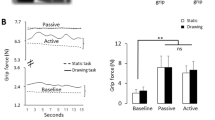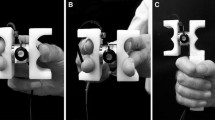Abstract
Sensory inputs from the digits are important in initiating and scaling automatic reactive grip responses that help prevent frictional slips when grasped objects are subjected to destabilizing load forces. In the present study we analyzed the contribution to grip-force control from mechanoreceptors located proximal to the digits when subjects held a small manipulandum between the tips of the thumb and index finger. Loads of various controlled amplitudes and rates were delivered tangential to the grip surfaces at unpredictable times. Grip forces (normal to the grip surfaces) and the position of the manipulandum were recorded. In addition, movements of hand and arm segments were assessed by recording the position of markers placed at critical points. Subjects performed test series during normal digital sensibility and during local anesthesia of the index finger and thumb. To grade the size of movements of tissues proximal to the digits caused by the loadings, three different conditions of arm and hand support were used; (1) in the hand-support condition the subjects used the three ulnar fingers to grasp a vertical dowel support and the forearm was supported in a vacuum cast; (2) in the forearm-support condition only the forearm was supported; finally, (3) in the no-support condition the arm was free. With normal digital sensibility the size of the movements proximal to the digits had small effects on the grip-force control. In contrast, the grip control was markedly influenced by the extent of such movements during digital anesthesia. The poorest control was observed in the hand-support condition, allowing essentially only digital movements. The grip responses were either absent or attenuated, with greatly prolonged onset latencies. In the forearm and no-support conditions, when marked wrist movements took place, both the frequency and the strength of grip-force responses were higher, and the grip response latencies were shorter. However, the performance never approached normal. It is concluded that sensory inputs from the digits are dominant in reactive grip control. However, nondigital sensory input may be used for some grip control during impaired digital sensibility. Furthermore, the quality of the control during impaired sensibility depends on the extent of movements evoked by the load in the distal, unanesthetized parts of the arm. The origin of these useful sensory signals is discussed.
Similar content being viewed by others
References
Burke D, Gandevia SC, Macefield G (1988) Responses to passive movement of receptors in joint, skin and muscle of the human hand. J Physiol (Lond) 402:347–361
Cole KJ, Abbs JH (1988) Grip force adjustments evoked by load force perturbations of grasped object. J Neurophysiol 60:1513–1522
Cole KJ, Johansson RS (1993) Friction at the digit-object interface scales the sensorimotor transform for grip responses to pulling loads. Exp Brain Res 95:523–532
Cole JD, Sedgwick EM (1992) The perception of force and of movement in a man without large myelinated sensory afferents below the neck. J Physiol (Lond) 449:503–515
Day BL, Riescher H, Struppler A, Rothwell JC, Marsden CD (1991) Changes in the response to magnetic and electrical stimulation of the motor cortex following muscle stretch in man. J Physiol (Lond) 433:41–57
Denny-Brown D (1966) The cerebral control of movement. Liverpool University Press, Liverpool
Deuschl G, Michels R, Berardelli A, Schenk E, Inghilleri M, Lücking CH (1991) Effects of electric and magnetic transcranial stimulation on long latency reflexes. Exp Brain Res 83:403–410
Dugas C, Smith AM (1992) Responses of cerebellar Purkinje cells to slip of a hand-held object. J Neurophysiol 67:483–495
Edin BB (1990) Finger joint movement sensitivity of noncutaneous mechanoreceptor afferents in the human radial nerve. Exp Brain Res 82:417–422
Edin BB (1992) A quantitative analysis of static strain sensitivity in human mechanoreceptors from hairy skin. J Neurophysiol 67:1105–1113
Edin BB, Abbs JH (1991) Finger movement responses of cutaneous mechanoreceptors in the dorsal skin of the human hand. J Neurophysiol 65:657–670
Edin BB, Westling G, Johansson RS (1992) Independent control of fingertip forces at individual digits during precision lifting in humans. J Physiol (Lond) 450, 547–564
Favilla M, Gordon J, Hening W, Ghez G (1990) Trajectory control in targeted force impulses. VII. Independent setting of amplitude and direction in response preparation. Exp Brain Res 79:530–538
Häger C, Bäckström L, Johansson RS (1989) Somatosensory control of grip force responses to unpredictable pulling loads during precision grip in man (abstract). Proc Int Union Physiol Sci XVII, Oy Liitto, Oulo Finland, p 531
Häger-Ross C, Cole KJ, Johansson RS (1996) Grip force responses to unanticipated object loading: load direction reveals body- and gravity-referenced intrinsic task variables. Exp Brain Res 110:142–150
Johansson RS, Cole KJ (1994) Grasp stability during manipulative actions. Can J Physiol Pharmacol 72:511–524
Johansson RS, Edin BB (1993) Predictive feedforward sensory control during grasping and manipulation in man. Biomed Res 14:95–106
Johansson RS, Vallbo ÅB (1979) Tactile sensibility in the human hand: relative and absolute densities of four types of mechanoreceptive units in the glabrous skin. J Physiol (Lond) 286:283–300
Johansson RS, Westling G (1984a) Roles of glabrous skin receptors and sensorimotor memory in automatic control of precision grip when lifting rougher or more slippery objects. Exp Brain Res 56:550–64
Johansson RS, Westling G (1984b) Influences of cutaneous sensory input on the motor coordination during precision manipulation. In: Euler C von, Franzén O, Lindblom U, Ottosson D (eds) Somatosensory mechanisms. Macmillan, London, pp 249–260
Johansson RS, Westling G (1987) Signals in tactile afferents from the fingers eliciting adaptive motor responses during precision grip. Exp Brain Res 66:141–154
Johansson RS, Westling G (1988) Programmed and triggered actions to rapid load changes during precision grip. Exp Brain Res 71:72–86
Johansson RS, Riso R, Häger C, Bäckström L (1992a) Somatosensory control of precision grip during unpredictable pulling loads. I. Changes in load force amplitude. Exp Brain Res 89:181–191
Johansson RS, Häger C, Riso R (1992b) Somatosensory control of precision grip during unpredictable pulling loads. II. Changes in load force rate. Exp Brain Res 89:192–203
Johansson RS, Häger C, Bäckström L (1992c) Somatosensory control of precision grip during unpredictable pulling loads. III. Impairments during digital anesthesia. Exp Brain Res 89:204–213
Johansson RS, Lemon RN, Westling G (1994) Time varying enhancement of human cortical excitability mediated by cutaneous inputs during precision grip. J Physiol (Lond) 481:761–775
Jones LA, Hunter IW (1992) Changes in pinch force with bidirectional load forces. J Mot Behav 24:157–164
Knibestöl M, Vallbo Å (1970) Single unit analysis of mechanoreceptor activity from the human glabrous skin. Acta Physiol Scand 80:178–195
Lacquaniti F (1992) Automatic control of limb movement and posture. Curr Opin Neurobiol 2:807–814
Macefield VG, Johansson RS (1996) Control of grip force during restraint of an object held between finger and thumb: responses of muscle and joint afferents from the digits. Exp Brain Res 108:172–184
Macefield VG, Häger-Ross C, Johansson RS (1995) Control of grip force during restraint of an object held between finger and thumb:responses of cutaneous afferents from the digits. Exp Brain Res 108:155–171
McCloskey DI, Gandevia S, Potter ED, Colebatch SG (1983) Muscle sense and effort: motor commands and judgments about muscular contractions. In: Desmedt JE (ed) Motor control mechanisms in health and disease. Raven, New York, pp 151–168
Moberg E (1962) Criticism and study of methods for examining sensibility in the hand. Neurology 12:8–19
Mott FW, Sherrington CS (1895) Experiments upon the influence of sensory nerves upon movement and nutrition of the limbs. Proc R Soc Lond [Biol] 57:481–488
Nakashima K, Rothwell JC, Day BL, Thompson PD, Marsden CD (1990) Cutaneous effects on presynaptic inhibition of flexor Ia afferents in the human forearm. J Physiol (Lond) 426:369–380
Nielsen J, Pierrot-Deseilligny E (1991) Pattern of cutaneous inhibition of the propriospinal-like excitation to human upper limb motoneurons. J Physiol (Lond) 434:169–182
Palmer E, Ashby P (1992a) Evidence that a long-latency stretch reflex in humans is transcortical. J Physiol (Lond) 449:429–440
Palmer E, Ashby P (1992b) The transcortical nature of the late reflex responses in human small hand muscle to digital nerve stimulation. Exp Brain Res 91:320–326
Picard N, Smith AM (1992) Primary motor cortical responses to object slip during prehension. J Neurophysiol 68:1882–1894
Poulton EC (1981) Human manual control. In: Brooks VB (ed) Motor control. (Handbook of physiology, sect 1, The nervous system, vol II) American Physiological Society, Bethesda, pp 1337–1389
Rothwell JC, Traub MM, Day BL, Obeso JA, Thomas PK, Marsden CD (1982) Manual motor performance in a deafferented man. Brain 105:515–542
Twitchell TE (1954) Sensory factors in purposive movements. J Neurophysiol 17:239–252
Westling G, Johansson RS (1984) Factors influencing the force control during precision grip. Exp Brain Res 53:277–284
Westling G, Johansson RS (1987) Responses in glabrous skin mechanoreceptors during precision grip in humans. Exp Brain Res 66:128–40.
Author information
Authors and Affiliations
Rights and permissions
About this article
Cite this article
Häger-Ross, C., Johansson, R.S. Nondigital afferent input in reactive control of fingertip forces during precision grip. Exp Brain Res 110, 131–141 (1996). https://doi.org/10.1007/BF00241382
Received:
Accepted:
Issue Date:
DOI: https://doi.org/10.1007/BF00241382




